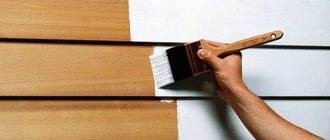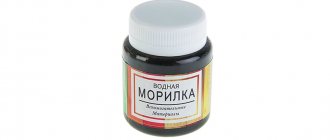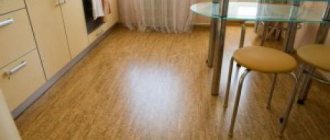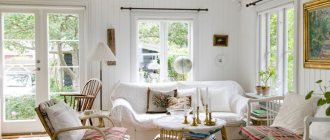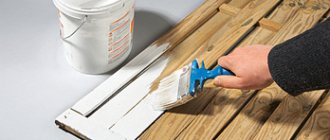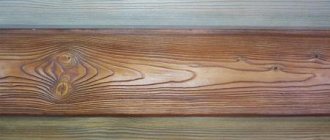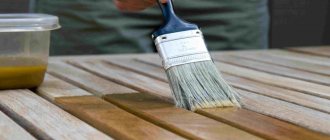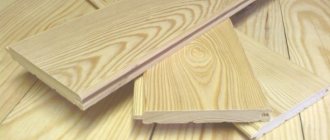Varnish for treating lining inside the house is a universal product that protects the surface of wood from moisture, insects, mechanical damage and at the same time creates a decorative coating. Transparent shiny or matte film gives smoothness to the finishing profile and emphasizes the unique texture of the wood.
The construction industry offers different types of paints and varnishes for interior work. How to navigate this diversity and choose the most suitable varnish option for lining?
Origin of varnish
The word “varnish” came to us from the East. Wood treatment with protective substances was used back in Ancient India. Translated from Hindi, “lakh” is the number 100,000, which is a lot. It means a large number of kerria yakka insects, the secretion of which was used to make natural shellac resin.
The invention of varnish dates back to the beginning of the 12th century. The first mention of him was in the monastic records of the scribe Theophilos. The production of the substance was shrouded in mystery; the secret recipe was not disclosed. It is most likely that ethyl alcohol served as a solvent in those days.
Later, at the beginning of the 19th century, the French chemist Chenet built a factory where varnishes were produced based on processed oils and resins exported from colonial countries. His compatriot Violet devoted himself to studying the properties of the material and a little later published the results of chemical research, thus declassifying the secret of the creation of the substance.
In the second half of the 19th century, active construction of oil and varnish factories began in Europe and Russia. This was due to the development of railway networks. Wooden sleepers, carriages, and in some places rails required protection from water.
Currently, the raw materials for the production of varnishes are natural and synthetic resins, esters, and oils.
Water or organic substances are used as a solvent.
Frame bathhouse and Neomid
The first project is a frame house, which can hardly be called a typical bathhouse. Most likely, this is a full-fledged house with a bathhouse, since it has both a living area with a kitchen and a bathhouse itself.
This is what a bathhouse with living space looks like on the customer’s site
The entire room of the house is lined with clapboard, we will also paint it outside and inside, but today I will tell you how the clapboard for the bath was impregnated in the “wet zone” - the steam room and the washing room.
In the photo - a washing room with a bucket for hardening lovers
I had to choose a wood treatment product together with the owner, because... I prefer not to impose my opinion regarding consumables. I am responsible for processing the lining in the bathhouse, and the client is responsible for impregnating the lining in the bathhouse.
Steam room and shelves
Composition selection
At the local construction supermarket there were about 8 compounds of different price categories to choose from. The client chose NEOMID products, namely oil for baths and saunas. The price for a 0.25 liter bottle in the spring of 2022 was 270 rubles.
To treat the washing room and steam room, we purchased 8 bottles of 0.25 liters each. The instructions on the packaging kindly stated that the average consumption when applying the product in one layer is about 40 to 60 g/m2.
Calculator for calculating material requirements from the official website
Accordingly, for 30 squares of available surfaces, about 1.8-2.0 liters are needed. We took it with a small reserve and were not disappointed.
Our choice in favor of a domestic manufacturer
In such a situation, the following calculation formula will help you:
To avoid buying too much, calculate the required amount of protective composition in advance.
Application process
It's time to tell how the lining was processed in the bathhouse.
Pay maximum attention to polishing the shelf - you are supposed to sit on it
First we had to prepare the surfaces:
- Walls. Since we bought high-quality lining for the bathhouse, no special preparation was required - I used a large soft brush to sweep away the dust from the walls;
- Shelf. Here I had to be patient and carefully sand all surfaces. To do this I used a piece of block and sandpaper. At the end I also swept away all the dust.
Everything is ready to apply the protective composition
- Tools. We will need a plastic paint tray, a narrow brush and a soft rag;
- Means of protection. Since we use environmentally friendly impregnations, we skip this point.
Apply the composition with a brush and rub thoroughly
The whole job took me 3 hours, including the time to dry the first layer. When finished, I wiped the shelves with a soft, lint-free cloth to remove any excess protective compound. When the second layer had dried, I splashed water on the shelf - it formed droplets.
Processing of lining for a bath is carried out with a brushRequirements for paint and varnish materials for interior work
According to GOST 9825, 28246, 33289, varnish for lining is classified as a weather-resistant or limited weather-resistant volatile organic compound. The first type is used for exterior decoration, the second - indoors. They produce universal types of coatings that can be used in different conditions.
Guests regulate the characteristics of paints and varnishes for interior work:
- The appearance and color of the coating is indicated in the regulatory or technical document (ND, TD) for the product; wrinkles, craters or other defects on the surface after drying are not allowed;
- Drying time at a temperature of 20 °C – no more than 72 hours;
- Covering capacity 120-150 g/m²;
- Adhesion to various surfaces 0-1 point;
- Elasticity when bending the film up to 1 mm;
- Strength according to the device – U-1 40 cm;
- Hardness – 0.05-0.15 relative units;
- Conditional light fastness – 2-12 hours;
- Resistant to water for at least 24 hours;
- Wet abrasion in microns and vapor permeability in g/m² are indicated in ND or TD;
- Service life – at least 1-2 years;
- The content of non-volatile substances is not less than 30%.
Packaging and labeling of the material must comply with GOST 9980.3, 9980.4.
Information about the manufacturer is required, indicating the legal address, production date and ND for the product. Indicate the purpose, rules of use, precautions, expiration date. The manufacturer can undergo product certification on a voluntary basis.
Varnish for lining is designated by two capital letters corresponding to the name of the main film-forming substance in the composition. For example, AU is alkyd-urethane, EF is epoxy ester. Water-dispersed liquids have an additional index of VD.
The container must comply with standards and pass drop tests. Cans or canisters filled with a viscous substance with a given density are thrown from a height of 0.4-0.6 m. The packaging should not be damaged.
Use glass, metal or polymer jars, canisters, bottles with a volume of 0.04-20 dm³. The mass content of varnish in the container should not deviate from the nominal value by more than 5%.
Varnishes are allowed for production after a hygienic assessment by the bodies of the State Sanitary and Epidemiological Supervision of the Russian Federation with the issuance of a conclusion. The manufacturer guarantees the safety of the product for the life and health of the buyer, and the preservation of properties until the expiration date. After its expiration, paintwork materials are not used for their intended purpose.
What to consider additionally
There are several nuances, taking into account which you can create a very durable, high-quality and aesthetic coating:
- Regardless of the type of varnish chosen, maximum strength can be achieved by applying it in 2 layers.
- If the varnish is available for sale in two forms: translucent and completely transparent, apply the second option first. The surface will receive a certain, more saturated shade, but at the same time the structure of the wood will be preserved for visual inspection.
- We must not forget about the protective impregnation against biocorrosion, which must be carefully treated with the lining before varnishing.
- During operation, the varnishing agent is often stirred to maintain a uniform structure. When the first layer is completely dry, you need to sand it a little and only then re-paint the lining inside the house.
Coating the lining with varnishes does not present any particular difficulties. The owner of the house can cope with such work himself. Especially if it uses the information provided.
Raw materials
The main component of varnish is resins, which are of natural or synthetic origin. When the solvent evaporates, it is they that form a film on the surface of the wood. The quality of the coating directly depends on the characteristics of this ingredient.
Natural resins
Shellac is the first resin that man began to extract and use for his needs. The viscous secretion secreted by female scale insects covered subtropical trees with crusts. It was scraped, melted, strained and rubbed onto wooden surfaces. Now shellac is used to make alcohol-based varnish. Its coating is durable, but not resistant enough to water and high temperatures.
Therefore, shellac varnish for lining is not used for finishing the internal walls of baths, saunas and other rooms with high humidity.
Rosin is a substance obtained from the resin of coniferous trees by evaporating turpentine. Dissolves in organic liquids - alcohol, ether, acetone, benzene. Varnishes based on glycerin ether of rosin - harpius - and its phenolic modifications are widely used for treating wood indoors. These are KF-274, KF-965, MA-594 and others.
Amber is a fossil resin. Varnish based on it is produced in small quantities, since the raw material is quite rare. It forms a very strong, shiny and stable film. Before the revolution in our country, it was produced on an industrial scale, but now the products belong to the premium class. For example, the cost of packaging 1 liter of YAN-153 is 2000 rubles.
Resins from exotic tropical trees - sandarac, gummilak, copala, dammara - are used to produce artistic varnishes.
Synthetic resins are gradually replacing natural ones.
Their production is cheaper, and the quality of the resulting products is not inferior to, and sometimes superior to, natural analogues.
Synthetic resins
With the development of plastic production, polymers appeared that have valuable qualities for the manufacture of varnishes - high adhesion, heat resistance, strength, and resistance to aggressive influences.
Alkyd, polyvinyl acetate, polyacrylate, indene-coumaron, phenol-formaldehyde and other resins are used to produce high-quality varnishes intended for external and internal finishing of buildings.
Oils
Vegetable oils are the starting material for oil varnishes. They form a hard elastic film when dry. For production, a product of processing raw linseed, soybean, tung, hemp, camelina or castor oils is used. They are melted with resins, boiled down, and hardening accelerators—driers—and other substances that improve the properties of the mixtures are added.
In the middle of the last century in our country, the production of oil-based varnishes reached 80%. Now the share of natural raw materials in the coatings industry has decreased, although it still remains significant. They were replaced by synthetic substances obtained by the polymerization of hydrocarbons.
The films formed during processing with oil varnishes have a beautiful soft shine, high elasticity, and strength.
They are not very resistant to precipitation, but are widely used as interior finishing for lining indoors.
Solvents
Solvents are volatile substances, the evaporation of which leaves a film of resins or polymers on the surface. When decorating interiors, they must dry quickly and not emit toxic substances. The most harmless solvent is water, but, unfortunately, not all resins dissolve in it. Organic compounds - ethyl and methyl alcohol, acetone, white spirit, turpentine - transform polymers into a fluid state and quickly evaporate after applying varnish to the surface.
Sometimes, to give the wood a tint, dyes are added to the varnish - substances soluble in film formers that give colored transparent coatings. This allows you to get an imitation of an exotic species from ordinary wood.
Why use impregnation?
Some owners have doubts about the need to impregnate wood paneling inside a suburban building. If the boards are not covered, changes will be noticeable on them after some time. With poor ventilation, the lining will appear blue; as a result of intense sunlight, it may become dark gray.
The blueness is explained by the action of microorganisms, which can be gotten rid of with the help of active oxidizing agents, such as chlorine. The procedure is not very easy to perform and is accompanied by the release of an unpleasant odor.
The plaque, which has turned gray from the sun, can be removed by mechanical grinding of the lining, but the positive effect will not last long. It is more advisable to carry out the treatment immediately after finishing, so as not to have problems later.
In addition, the coating transforms the wood and makes the interior special. Lining coated with waterproof impregnation can last longer even in an irregularly heated, damp room.
Types of varnishes for lining
For the protective and decorative treatment of wooden profiles, different types of varnishes are used:
Alkyd. The base is glyphthalic, pentaphthalic or ethrifthalic resin mixed with organic solvents (white spirit, solventnaphtha) and driers. The film on the surface is formed during a chemical reaction - polymerization or polycondensation. Varnishes have high adhesion, water resistance, transparency and durability. They protect wood well from photoaging, as they are not afraid of ultraviolet radiation. Disadvantages include long drying time and strong odor.
Acrylic. The emulsion of acrylic resin and water has a milky white color. After the liquid evaporates, the varnish becomes transparent. Due to the characteristics of hardening, it is used in dry heated rooms, since at high humidity the formation of the film slows down. Water-based acrylic varnish for finishing lining is one of the most non-toxic compositions, therefore it is widely used for interior work. They can be used to treat walls in a bathhouse or sauna without fear of harmful emissions during water procedures. They are also suitable for decorating children's rooms. Disadvantage: low resistance to mechanical damage.
Polyurethane. They are characterized by quick drying, high strength of the film formed, and good adhesion to wooden surfaces. Water-soluble one-component and two-component forms consisting of a base and a hardener are used. Coatings can be glossy, matte or semi-matte; special additives provide self-leveling properties. The surface treated with polyurethane varnish is very wear-resistant.
Oily. They are solutions of polymer or natural resins in oils. Compositions with a reduced oil content (lean) are used in interior decoration, since their weather resistance is low. Thicker varnishes are used for outdoor work.
Protection procedure
Typically, coniferous and hardwood panels, which are subject to the aging process, are used to upholster the interior walls of rooms. Even if the type of wood was chosen, depending on the load planned for the room. However, such an undesirable aging process can be significantly slowed down.
Applying a protective layer to the lining
Speaking about the list of negative factors that have a detrimental effect on the lining, the following should be highlighted:
- FACTOR 1: Increased solar radiation.
- FACTOR 2: High air humidity, contact of wood with water is especially detrimental.
- FACTOR 3: Pest bugs.
- FACTOR 4: Mechanical damage.
- FACTOR 5: Growth of microorganisms on the surface of the lining.
Application
Before using varnish for lining based on organic solvents, the surfaces are prepared - dried, cleaned and primed with varnish diluted by 10% or with a suitable primer. This procedure will enhance the adhesion of the base coating and reduce material consumption.
After drying, sand the lining with fine-grained sandpaper in the direction of the grain. Remove small particles from the surface with a soft cloth.
Apply the first layer of undiluted protective substance with a brush in the longitudinal and then in the transverse direction. The work is done quickly, making sure that there are no traces of the brush left, since the film sets when the solvent evaporates.
Repeat sanding after the previous layer has dried and apply the next one. The recommended number of repetitions is at least two.
Water-soluble varnish for lining is used in a similar way. The peculiarity is that after absorbing water, the wood fibers swell and rise above the surface. Therefore, the wood is first moistened and sanded with moisture-resistant fine-grained sandpaper, wiped with a cloth, and then covered with a layer of varnish. Apply the substance generously, multiply up to 3 times.
Main purpose of wood processing
After covering the interior with clapboard, it is necessary to carry out the first surface treatment no later than a week later. By using a varnish that is correctly selected for the conditions of the internal microclimate, you will be able to guarantee the material:
- durability - after treatment with varnish, the appearance of fungus, mold, and rotting processes is no longer possible;
- aesthetics – neutral reaction to UV radiation;
- improved performance – the outer layer protects against impacts and other types of physical impact;
- fire resistance – protected wood can withstand strong flame pressure.
Regardless of the type of varnish chosen, the lining is pre-treated with various materials: drying oil, antiseptic, protective impregnation, stain, or subjected to heat treatment. To perform this procedure yourself, a burner is used to slowly scorch the top layer of each element, achieving uniform darkening.
During processing, especially with coniferous trees, resin is released, which gives the lining a special originality. However, now such operations are carried out much less frequently, since more effective protective agents and varnishes are available on sale, the work with which is carried out much faster.
Precautions during operation
When working with varnishes, observe safety precautions. Organic solvents are highly flammable, so do not use open flames or smoke. The room must have effective natural or forced ventilation, since the evaporation of volatile compounds in the air increases the level of toxic substances. When using the sprayer, wear a respirator or bandage to protect the respiratory system.
All materials are stored separately, avoiding places with direct sunlight and away from heating devices.
Fighting methods
There are many methods, natural and synthetic products.
Medium 1: resin
Resin heated before application helps against fungal spores.
Pros:
- effective,
- safe,
- cheap.
Minuses:
- The surface remains sticky.
- The resin is viscous, difficult to apply, you need to stretch it.
Remedy 2: silicate glue
Silicate glue diluted to a state of medium ductility is used. It is used to treat the surfaces of wooden products and coatings 1–2 times.
This is a safe hypoallergenic composition. Has a short-term effect, not suitable for some types of mold.
Remedy 3: potassium dichromate, sulfuric acid
A 5% solution of potassium dichromate and a 5% sulfuric acid concentrate are mixed in equal proportions.
The resulting solution is used to treat the boards and soil adjacent to the structures. The method is effective, but dangerous for the soil.
To get rid of an existing outbreak, sprinkle the area with soda and spray with 9 or 6% acetic acid.
Remedy 5: salt, acid, boiling water
Prepare a solution from 5 liters of hot boiled water, 1 kg of table salt, 50 g of boric acid. Mix thoroughly and process the wood.
Remedy 6: copper sulfate
Take 100 g of dry matter and dilute it in 10 liters of water. The boards are treated with the solution, then dried and used for construction.
Remedy 7: whiteness
Chlorine bleach works well to remove fungus, but keep in mind that the liquid lightens the wood.
In baths and saunas, it is possible to remove mushrooms only using folk remedies. To cure the affected area, clean the boards with soda, pour vinegar on them, and wait for the reaction to complete. Then wash off the reagents with water and cover the area with tea tree oil diluted in warm water.
Folk remedies are not always effective and safe. They are used when there are no special drugs at hand, and the problem needs to be solved quickly.
How to choose a composition
When choosing a suitable mixture for processing, it is first necessary to take into account the operating conditions of the facing material. A loggia or balcony cannot always be considered an outdoor space, for example, if there is normal glazing and appropriate perimeter cladding. In such cases, it is quite possible to use materials for interior decoration.
The absence of glazing or its poor quality implementation will not provide sufficient protection from adverse atmospheric influences, which is why materials for interior work will be ineffective. Unglazed balconies are classified as external structures and require appropriate treatment products (facade paints, varnishes, primers, etc.).
In addition to paints and varnishes, various types of antiseptics and agents are also used that give the wood additional properties, for example, resistance to fire. The use of such products is necessary for ordinary lining - euro lining is sold pre-treated.
